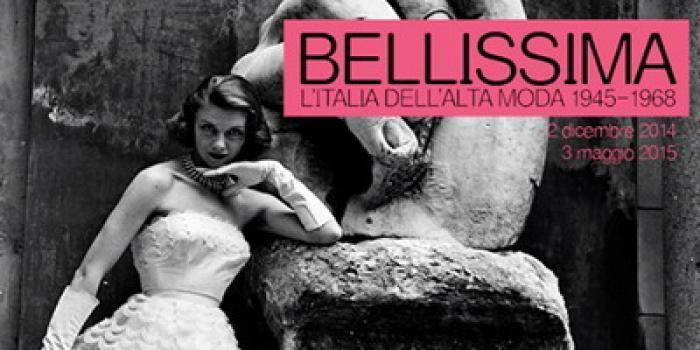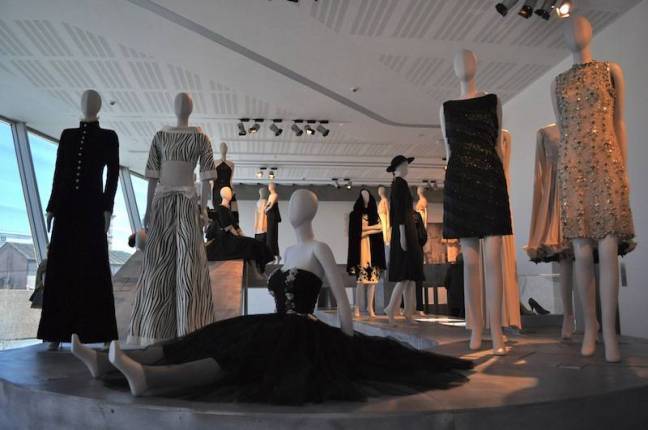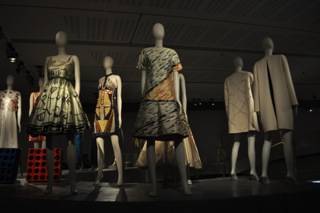Bellissima. Italian Fashion Through the Seasons
MAXXI, the nearly five-year-old contemporary art museum located in the Flaminio district of Rome, describes its mission as not simply a place to display art. Rather, the museum hopes to function, among other things, as a place for “cultural innovation and the overlapping of languages.”
“Bellissima” features relatively few items of clothing and accessories, but the limited scope allows the viewer to spend more time appreciating individual objects.
As the wall labels (in Italian and English) explain, the show does not present a history of clothing but “stages a selection of outfits by a series of authors to whom is due the very identity of Italian fashion, revealing its themes and distinguishing features.”
Mannequins populate an elevated catwalk that resembles a baggage carousel crossed with a racetrack. Nonetheless, the dresses, jumpsuits, and coats worn by the figurines are anything but the kind of mass-produced “fast fashion” that’s shoved into a suitcase and checked at the airport with a prayer that it doesn’t get lost on the way.
In keeping with their interest in the artistic dimension of “l’alta moda,” the curators of “Bellissima” feature a number of items of clothing that required incredible handiwork, including the beading and embroidery we associate with couture.
Taking this notion a bit further, the mannequins share the catwalk with actual works of painting and sculpture, many from the Galleria Nazionale d’Arte Moderna of Rome.
In some cases, these comparisons serve solely to establish a shared aesthetic. In other examples, the connection is more direct, as with a 1965 Roberto Capucci dress identified as an “Homage to Vasarely,” a founder of the Op Art movement.
Capucci’s dress is not created from printed fabric; instead, the visual effect is created by weaving black and white satin ribbons and is displayed alongside prints by Alberto Biasi that make use of similar optical illusions. And one item from 1962, a simple shantung day dress by Germana Marucelli, served as the canvas for strokes of color hand-painted by Paolo Scheggi, a Settignano-born artist whose works from the 1960s have recently grown in popularity.
Some items derive their interest as much from their history as their beauty, especially in the section devoted to cinema and “Hollywood on the Tiber.”
A mannequin clad in a dress made around 1953 by Emilio Schuberth for Gina Lollobrigida sprawls on the catwalk, her saucy attitude and the dress’s ample strapless bodice alluding to La Lollobridiga’s status as a sex symbol.
Glass cases built into the catwalk hold gold kid stilettos worn by Marilyn Monroe in “Bus Stop” (1956) as well as a tiny pair of lace sandals made for beloved Italian actress Anna Magnani (star of the 1951 Visconti film from which the exhibition takes its name). Hats, bags, and jewelry by Bulgari (the exhibition’s main partner) and others complete the head-to-toe aspect of wearable art.
Additional materials on display in “Bellissima” allude to the diffusion of Italian fashion. A few stunning giant photographs ring the room, including a 1958 image by Federico Garollo of two women in polka-dotted Valentino dresses that is the very essence of mid-20th century Italian moda.
Screens set into the catwalk project a variety of programs devoted to Italian fashion, providing a less static view of the period under discussion. If you can get to Rome before the show closes on March 5, the easy trip to MAXXI from the Centro Storico via Metro and tram is worth the effort. If not, an enormous exhibition catalogue, published in an English version, provides more specific information on pieces in the show as well as the fashion scenes in a number of Italian cities.









































i-Italy
Facebook
Google+
This work may not be reproduced, in whole or in part, without prior written permission.
Questo lavoro non può essere riprodotto, in tutto o in parte, senza permesso scritto.